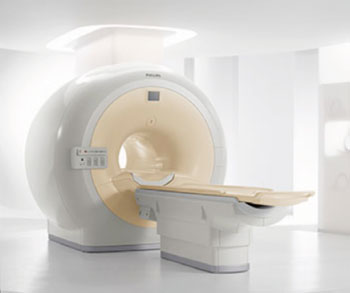Imaging Shows Asymptomatic Atherosclerosis Linked to Cognitive Impairment
By MedImaging International staff writers
Posted on 07 Dec 2014
In an imaging study of nearly 2,000 adults, researchers found that an accumulation of plaque in the body’s major arteries was linked with mild cognitive impairment. Posted on 07 Dec 2014
The study’s findings were conducted at the University of Texas (UT) Southwestern Medical Center (Dallas, USA) and presented December 2014 at the annual meeting of the Radiological Society of North America (RSNA), held in Chicago (IL, USA). “It is well established that plaque buildup in the arteries is a predictor of heart disease, but the relationship between atherosclerosis and brain health is less clear,” said Christopher D. Maroules, MD, a radiology resident at UT Southwestern Medical Center in Dallas. “Our findings suggest that atherosclerosis not only affects the heart but also brain health.”

Image: The Philips Healthcare Achieva MRI system (Photo courtesy of RSNA).
Atherosclerosis is a disorder in which cholesterol, fat, and other substances gather in the arteries, forming a substance called plaque that can build up, restricting blood flow. It can occur in any artery of the body, including the carotid, which supplies blood to the brain, coronary arteries and the aorta, which carries oxygenated blood from the heart through the abdomen to the rest of body.
In the study, researchers analyzed the test results of 1,903 participants (mean age, 44 years) in the Dallas Heart Study, a multiethnic population-based study of adults from Dallas County, Texas. The participants included both men and women who had no symptoms of cardiovascular disease. Study participants completed the Montreal Cognitive Assessment (MoCA), a 30-point standardized test for detecting mild cognitive impairment, and underwent magnetic resonance imaging (MRI) of the brain to identify white matter hyperintensity (WMH) volume. Bright white spots known as high signal intensity areas on a brain MR images indicate abnormal changes within the white matter. “Increased white matter hyperintensity volume is part of the normal aging process,” Dr. Maroules explained. “But excessive WMH volume is a marker for cognitive impairment.”
Study participants also underwent imaging exams to measure the buildup of plaque in the arteries in three distinct vascular areas of the body: MRI to measure wall thickness in the carotid arteries and the abdominal aorta, and computed tomography (CT) to measure coronary artery calcium, or the amount of calcified plaque in the arteries of the heart.
Using the findings, researchers performed a statistical regression to correlate the incidence of atherosclerosis and mild cognitive impairment. After adjusting for traditional risk factors for atherosclerosis, including age, ethnicity, male sex, diabetes, hypertension, smoking, and body mass index, they found independent relationships between atherosclerosis in all three vascular areas of the body and cognitive health, as measured by MoCA scores and white matter hyperintensity volume on MR images.
Individuals in the highest quartile of internal carotid wall thickness were 21% more likely to have cognitive impairment as measured by a low MoCA score. An increasing coronary artery calcium score was predictive of large white matter intensity volume on MRI. “These results underscore the importance of identifying atherosclerosis in its early stages, not just to help preserve heart function, but also to preserve cognition and brain health,” Dr. Maroules said.
Dr. Maroules noted that the MRI and CT imaging techniques provide valuable prognostic information about an individual’s downstream health risks. “Plaque buildup in blood vessels throughout the body offers us a window into brain health,” he said. “Imaging with CT and MRI has an important role in identifying patients who are at a higher risk for cognitive impairment.”
RSNA (Oak Brook, IL, USA) is an association of more than 54,000 radiologists, radiation oncologists, medical physicists and related scientists, encouraging excellence in patient care and health care delivery through education, research and technologic advances.
Related Links:
University of Texas Southwestern Medical Center














